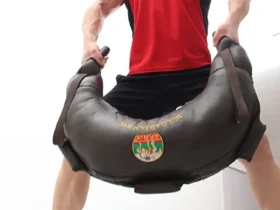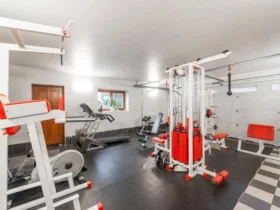
Battle Ropes Buying Guide
Created by John Brookfield 1yeah, never heard of him either, battling ropes are a relatively newcomer to the fitness industry. John’s system – created in 2007 – was designed so that the battle ropes can be used as a stand-alone exercise system or as part of a larger, integrated training plan.
While I haven’t used a rope very often (yet), it’s definitely an alternative training tool that is killer. It’s also quite unique with a heavy focus on speed or power 2In Physics, Power = Work / elapsed Time. Unlike weightlifting or even sandbags, there’s no lull in the action. Your mind and body have to stay engaged the whole time if you want actually do the exercise. If you’ve ever ridden an assault bike you’ll know what I’m talking about.
If you just want to buy a battle rope, see this detailed breakdown of some of the top Amazon battle ropes. If you want to know what to look for first, read on to learn the basics and some common options.
Battle Rope Basics
Battling ropes come in multiple thicknesses, weight, and length. Generally, though, battle ropes have two standard diameters (1.5 inch and 2 inch) and three standard lengths (30 foot, 40 foot, and 50 foot). Finding the one appropriate for you is based on your goals, space, and budget. I’ll give you some more details below so you can choose the right one.
There are three common movement patterns that you can perform with battle ropes: the wave, slams, and pulls. The wave is where one makes a continuous wave with the ropes. Slams are similar to making the wave, except the rope is slammed each time. Pulls are when one pulls the rope towards oneself, either simultaneously or alternatively.
Battle ropes are fantastic for Tabata or HIIT (high-intensity interval training) due the constant movement and force needed for it. However, John claims his system “teaches people how to sustain over time” and that someone should be able to go “go non-stop for at least twenty minutes pretty hard.” I can’t do that but it’s something that should be attainable if you stick with it.
Rather than try to explain how to do use it and do some of the exercises, it’s easier just to watch this video –
Battle Rope Advantages
There are quite a few reasons why battle ropes should be part of your training arsenal. Here are 6 of them –
1.Extremely Safe – unlike barbells or dumbbells, a battle rope cannot add additional force back on to you. You can only put as much force on that rope as your body is capable of producing. Because of that, the load on joints tends to be comparatively small. This is actually very important for injury prevention and for injury rehab. Physical therapists will use even battle ropes with somebody who has a rotator cuff injury
2. Easy to Use – Basic rope technique can be picked pretty easily and by almost everyone. Older athletes tend to find it easy on the joints while kids find the ropes are fun play items.
3. Increased Power – With the ropes you’re creating power very quickly. That has a huge transference over to many sports such as mma, wrestling, and others. For example, boxers can employ them to help train for specific punches like jabs, crosses, and uppercuts.
4. Increased Sustainability – With battling ropes, you can increase intensity over a long(er) period of time. In short, you’re training your lactic acid threshold allowing you to go harder, for longer. Increased intensity has fantastic crossover with virtually all sports. If you’re a boxer, think of the additional volume of punches you can throw without fatigue. If you’re into BJJ, you’ll be able to sustain your rolling much longer.
5. Mental Toughness – Due to the continuous motion of the ropes, you’ll find it very challenging to maintain effort over anything longer than bursts of time. Grinding through a longer set is as much as mental challenge as a physical one.
6. Fix strength imbalances – Because you work each arm independently, you’ll quickly discover and work on any strength imbalances.
Battle Rope Weaknesses
Now, all that sounds great. So, what’s the catch? Well, there are a couple downsides to battle ropes. That’s why I don’t recommend training with them exclusively over a long period of time.
1.Limited exercises – By its very nature, it’s going to be difficult to use battle ropes for anything other than upper-body exercises. Now, you can still get a good core and overall workout. But it’s still not as versatile as a basic dumbbells or barbells.
2. Cannot increase load – Similarly, it’s almost impossible to add load to the rope. You can increase intensity easily by, say, decreasing rest intervals or upping your battling speed…but you can’t add weight to the rope. Now, obviously, you could just buy a thicker, heavier rope if you want do that. But it’s still an inherent limitation of the rope itself.
Material
When they first appeared on the scene, battle ropes were nothing more than, well, a long rope. Typically made of manilla, ropes have gotten quite a bit better since then. Today, ropes come in a variety of different sizes, weights, and materials.
You have essentially two material options when buying a battle rope:
- Poly Dacron – Poly Dacron is synthetic rope made from two substances: polypropylene and Dacron fibers. Those fibers are twisted together into strands, with the Dacron providing the strength in the outer braid. Polypropylene provides a lightweight core and additional strength. Using polypropylene for the core reduces weight and cost and makes the rope lighter.
- Manila – An organic fiber made from hemp, manila is more expensive than Poly Dacron. They are not ideal for indoors as they shed little fibers every time you use them. They can also get a little musty if if they happened to get wet.

My recommendation is to get a Poly Dacron rope as it’s cheap, durable, and won’t shed.
Of course, the ratio of polypropylene to Dacron is going to vary by manufacturer so some polydac ropes are going to be cheaper than other. Anything greater than 30% Polypropylene has that more fibrous feel and won’t be as fluid when used. Depending on your usage that may be okay but just be aware of the potential differences in polydac ropes.
Size
Like I mentioned above, battle ropes have two standard diameters: 1.5 inch and 2 inch. And they come in three standard lengths: 30 foot, 40 foot, and 50 foot. There are exceptions such as a 2.5″ but these are pretty rare and are more “specialty” items. In other words, you probably won’t find those battle ropes on Amazon or other mass retailers.
Length
The general rule is to get the longest rope your space allows. So I recommend the 50 foot length. Remember when sizing the rope: the length will be cut in half once you anchor it. So for a 50′ rope, you’ll need 25′ of space for the rope. You’ll also want to leave yourself some space; say, around 5 feet. So you’ll want about 30′ of space for a 50′ rope.

To be clear, the longer rope will not necessarily make the workout harder, but will definitely make your motions more “fluid”. The shorter lengths can catch because the undulations won’t make it all the way down the rope before they hit the anchor point and send feedback back through the rope.
Diameter

You have two main options when it comes to thickness: 1.5″ or 2″. I’d recommend 1.5″ for pretty much everyone. Why? Battle ropes can be used to build both strength and endurance, but the thicker ropes will simply be too hard for almost everyone. Even the strongest/fittest will burn out on a 2″ rope in 30 seconds if they’re not acclimated to it. There is one exception to kind in mind: if you’re already strong and you’re going for a strength workout, the 2″ may be ideal for you.
But for 99% of the population, I’d recommend first getting the 1.5.” Then, if you need to, once you’re experienced and feel like you’re ready for an additional challenge, upgrade to the 2″.
Additional Things to Keep In Mind
- Handles – Most ropes have handles at the end of them. This does two things: keeps the rope from unraveling over time and makes it more comfortable or easier to grip. Find a battle rope with durable handles as those can wear down easily in cheaper ropes.
- Protective Sleeve or Cover – A lot of ropes also have a protective cover or sheath over them. Typically made of Nylon, the cover is good to keep out dirt and debris. If you’re going to use the rope outside often, it may be a feature you want. It’s not a required feature, though, as there are plenty of great ropes without sleeves.
- Anchor – You will need to anchor the rope to something and many ropes include a metal anchor you can use to hold the rope steady. Other anchoring options include using carabiners and/or straps to secure the rope to another sturdy object (e.g. a heavy kettlebell, a tree, squat rack, etc.).

FAQs
Are battling ropes good for fat loss?
Absolutely! A study in the Journal of Strength and Conditioning Research found that a mere 10-minute battle-rope workout increases heart rate to peak levels and should be classed as high-intensity exercise.
While not directly tied to fat loss, another study even showed battle rope “training effectively improves multiple physical fitness dimensions and shooting accuracy in collegiate basketball players.” in other words, even if you’re a highly trained athlete, you can see physical improvements.
How long should my battle rope be?
A good rule-of-thumb is to get the longest rope your space allows. If possible, that means getting a 50′ rope. Remember when sizing the rope: the length will be cut in half once you anchor it. So for a 50′ rope, you’ll only need 25′ of space for the rope. Leave yourself an additional 5′ so you’ll need about 30′ total.
What size battle rope should I buy?
I’d recommend 1.5″ thick battle ropes. Why? Battle ropes can be used to build both strength and endurance, but the thicker ropes will simply be too hard for almost everyone.
What are some battle rope exercises?

While not as varied as a traditional dumbbell, there are still tons of exercises you can do with battle ropes such as waves, slams, and pulls. Some other examples:
– Squat Waves
– Seated Waves
– Overheard Press
– Snakes
– Jumping Jacks
and so on
How do I anchor the battle rope?

There are a few ways to anchor your rope:
1. Anchor – the best option for most. A lot of times they’re included when buying a rope but, if not, you can purchase them pretty cheap. Here’s a good one.
2. Use existing equipment – a secure squat rack or heavy kettlebell, for example
3. Use a carabiner and strap to secure to another object such as tree, playground equipment, or anything else sturdy.











Leave a Reply